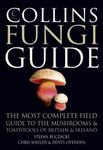This beautiful book, entirely in Serbian apart from the Foreword by Ann Pringle (Harvard University) and Acknowledgements, covers all major macromycetes found in Serbia and the western Balkans. The author is a well-known natural history TV-presenter and scientific writer in Serbia who previously prepared 'Jestive Glijvei i Lisajevi' [Edible Fungi and Lichens] in 2006 (a book that I have not seen). He is also the founder and President of the Mycologist's Association of Serbia and has been working on this guide along with his Association colleagues since 2003. It starts with a 21-page overview of what fungi are and their overall classification, stressing their position with respect to other kingdoms and introducing aspects of life-cycles, ecology, identification, edibility, cultivation, poison syndromes, and value as bioindicators. Almost the whole of the remaining book is devoted to species, and covers over 1500, of which around 1200 are illustrated in superb colour; apart from 102 ascomycetes, all those illustrated are basidiomycetes. These are preceded not by any formal key but by a series of 22 annotated boxed colour illustrations that directs the user to particular page-spans--a pragmatic approach I do not recall having seen used before in such a work and I am sure will help a great deal.
The species are arranged in a modern phylogenetic system by orders and families (sometimes grouped together) and also within them, which complicates locating particular taxa without recourse to the index. There are three species per page in a double-column format in which the inner columns have the text and the outer the photographs. This is very user-friendly and is almost ssidentical to that in the 'Encyclopedia of Fungi' (Jordan 2004). The text has the accepted name and author citation, ordinal placement, selected synonyms, sometimes a Serbian name, and information on morphology, microscopic features, chemical reactions, edibility, habitat, and distribution, sometimes with additional comments as well. The selection of species also includes photographs of some that are rarely illustrated, such as Amanita velosa, Rickenella mellea, and Xerocomus persicolor. The book finishes with a glossary, indices to scientific and Serbian names, and four pages of references.
Of course there are slips, such as the spelling Corficiales" for "Corticiales" (p. 71), and a misunderstanding over the use of the colon in citations as in Tubaria hiemalis "Romagnesi : Bon" rather than "Romagnesi ex Bon" (p. 351). And I am sure some macrofungal specialists would argue as to whether the species in all photographs were correctly identified. But these minutiae do not detract from the quality of the coloured images that make the volume a joy to leaf-through. This will be major stimulus to field mycology in the region, something recognized by the financial contributions towards the cost of publication received from Roger Phillips personally, the New Phytologist Trust, and three Serbian agencies. I understand that the possibility of a version in English is being explored, but in case that proves impractical, if you want a copy it should be ordered promptly as only 1000 copies have been printed and these will be much in demand in the region!"
- Prof. David L Hawksworth, Mycotaxon vol. 110






![Gljive Srbije i Zapadnog Balkana [Fungi of Serbia and the Western Balkans] Gljive Srbije i Zapadnog Balkana [Fungi of Serbia and the Western Balkans]](http://mediacdn.nhbs.com/jackets/jackets_resizer_xlarge/19/195842.jpg?height=620)
![Gljive Srbije i Zapadnog Balkana [Fungi of Serbia and the Western Balkans]](http://mediacdn.nhbs.com/jackets/jackets_resizer/19/195842.jpg)















